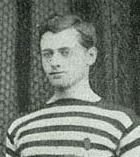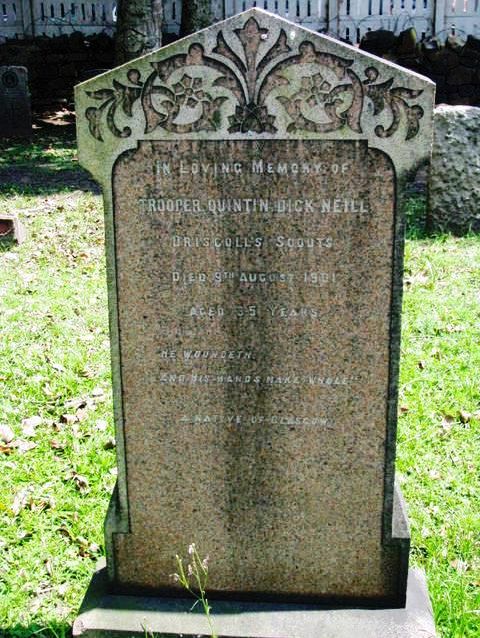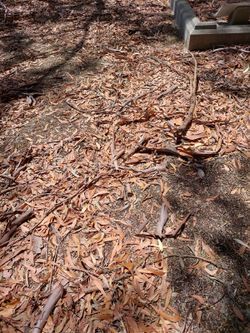Robert (and George and Quentin) Neill

Robert Neill's story is one of the strangest in Scottish football. He was born, the third (George was the fourth, Quintin the ninth) of thirteen, in 1853 in the Gorbals but the son of a school teacher, from Saltcoats, who would become the headmaster of the Gorbals Youths' School, and a mother from Rothesay. The school originally stood on Elgin St., now no more but then just by Eglinton Toll.
At seven Neill and the family were still on Glasgow Southside but by 1871 he and it had moved into what was then not quite the suburbs but semi-country-side still. In fact they were staying at Bellevue House, a Georgian building of some note, now demolished and replaced by Cathcart Police Station, Robert himself recorded as an Arts Student of seventeen at Glasgow University.
It meant that when football took off in Glasgow the elder Neill brother was staying just a mile from the Queen's Park and less still from the first Hampden Park, where at the former he, a full-back, began to turn out for the club of the same name from 1872 and at the latter from the following year. However, he was noticeably not in the Scotland cum Queen's Park team that would face England in November 1872, in fact only coming into the national team in 1876, by then aged twenty-two.
But from then on he was one of the four or so full-backs, who would be mixed and matched to form Scotland's final line of defence, he playing on either flank, captaining twice. That is until May 1880 and the Glasgow Charity Cup final. There he led his club to victory, albeit on a replay, over Rangers but received a knee injury that at just twenty-six ended a playing career, which, in addition to the five caps, had also included four Scottish Cups, the last just three months earlier, the first having been in 1874.
On having to hang up his boots it is said Robert spent a couple of years in South America, where precisely unknown, but had returned to Scotland by 1888. In fact there may have been another, or rather two factors that might have come into play and brought him home far earlier. By 1878 he had already lost his father, with in 1882 his also mother passing away, both at Bellevue House, he sixty, she just fifty-one, George already married but said to have played for Airdrieonians, Quintin by then aged sixteen, a clerk, still living at home and the youngest of the siblings just nine.
Quintin Neill was to join Queen's Park at twenty in 1886, no doubt with the recommendation of his brother. Also a full-back he would play for the club for two seasons, getting into the first team in 1888 and then doing something unprecedented, for Hampden anyway. He turned professional with Lincoln City, moving to the city, recorded as an accountant, there making well over 100 starts and remaining until 1894. Meantime, Robert has in 1888 married, his wife, Janet Johnston, living in Glasgow but originally from Tarbert in Argyll. By then he was working as a Commercial Traveller. They were to have four children, two of whom survived, he continuing as a salesman, latterly for an ironmonger before going into business on his own account as a a machinery-manufacturer.

By then younger brother, Quintin, had after football emigrated to South Africa. There he he volunteered for the Durban Light Infantry and with the outbreak of the Boer War joined the Driscoll's Scouts. It was a small group under the command of a Captain D.P. Driscoll of almost privateers, operating from 1900, mainly in the North-Eastern Cape. But outwith the fighting in mid-1901 and in an accident the younger Neill brother suffered a fractured skull and brain damage, which proved fatal. He died, seemingly unmarried at thirty-five in a Durban hospital. He is buried in the city's Addington Cemetery.

As for Robert, his story is if anything still stranger. In 1911, seemingly settled with wife and family, he simply walked out, only to re-emerge the following year in Western Australia. At home he was assumed dead. His wife would remarry. In Perth/Fremantle, however, he would have another life, find work as a labourer cum caretaker, trying meanwhile even at the age of sixty-four to volunteer to fight in The Great War. Indeed, he was to die, considerably respected in his adopted community but nevertheless in what appears to be an unmarked grave, at the age of seventy-five, bequeathing his possessions to his children still in Glasgow and be buried in the local Karrakatta Cemetery.
Birth Locator:
1853 - Clelland St., The Gorbals, Glasgow (Robert)
Residence Locations:
1861 - 20, South Apsley Place, Tradeston, Glasgow (Robert)
1871 - Bellevue House, (Now Hamden Park), Glasgow (Robert)
1881 - 3, Wendover Crescent, Mount Florida, Glasgow (Quintin)
South America (Robert)
1888 - 11, Hampden Terrace, Mount Florida, Glasgow (Robert)
1891 - 1, Regent Place, Shawlands, Glasgow (Robert)
The Limes. Craven St., Lincoln (Quintin)
I893-6 - Bellevue (Robert)
1900 - 2, Darnley Terrace, Shawlands, Glasgow (Robert)
1901-11 - 106, Kilmarnock Road, Shawlands, Glasgow (Robert)
1916 - The Retreat, Fremantle, Western Australia (Robert)
1921 - N/A
(1925 - Peoples Palace, Pier St., Perth, Western Australia) (Robert)
1928 - Perth, Australia (Robert)
Death Locator:
1901 - Durban , South Africa (Quintin)
1928 - Perth, Australia (Robert)
Grave Locator:
Durban Military Cemetery, Durban, South Africa (Quintin)
Karrakatta Cemetery, Nedlands City, Western Australia (Robert)
Back to the Queen's Park & Southern Suburbs Trail
or the SFHG Home page